Roger Marí
Radar Fields: An Extension of Radiance Fields to SAR
Dec 20, 2023



Abstract:Radiance fields have been a major breakthrough in the field of inverse rendering, novel view synthesis and 3D modeling of complex scenes from multi-view image collections. Since their introduction, it was shown that they could be extended to other modalities such as LiDAR, radio frequencies, X-ray or ultrasound. In this paper, we show that, despite the important difference between optical and synthetic aperture radar (SAR) image formation models, it is possible to extend radiance fields to radar images thus presenting the first "radar fields". This allows us to learn surface models using only collections of radar images, similar to how regular radiance fields are learned and with the same computational complexity on average. Thanks to similarities in how both fields are defined, this work also shows a potential for hybrid methods combining both optical and SAR images.
NeRF, meet differential geometry!
Jun 29, 2022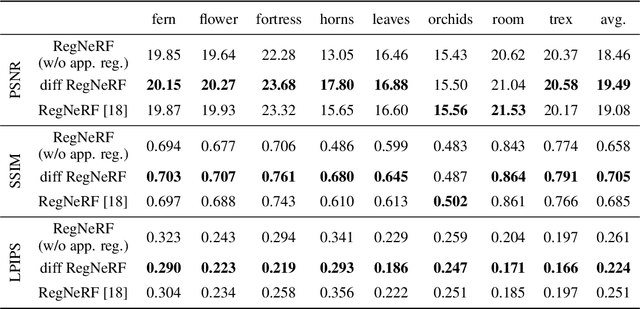
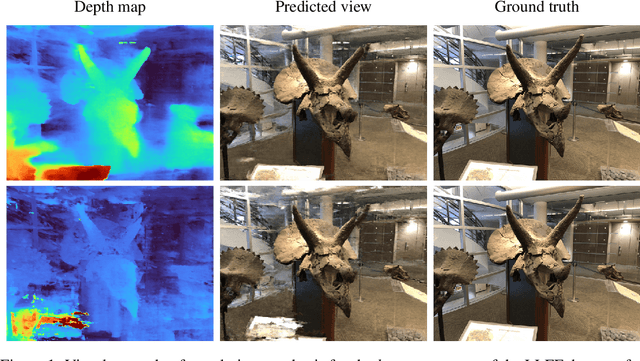
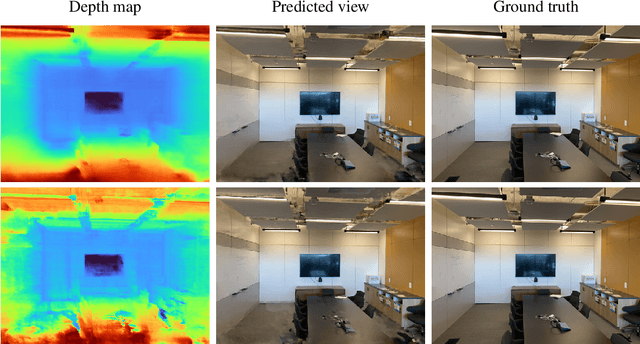
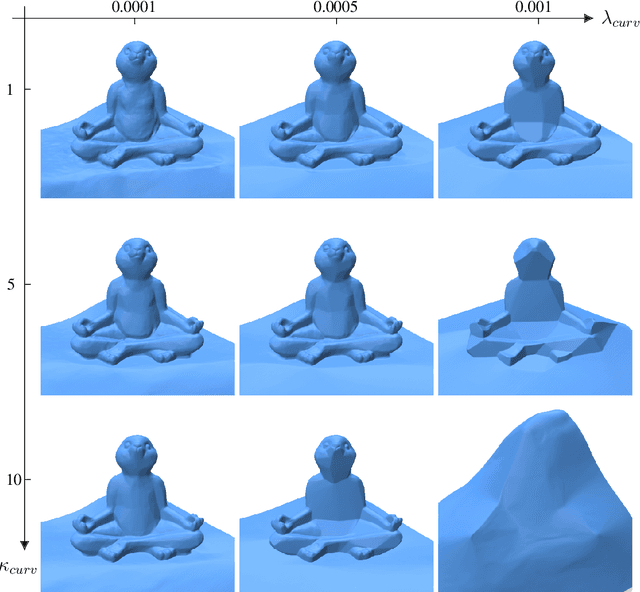
Abstract:Neural radiance fields, or NeRF, represent a breakthrough in the field of novel view synthesis and 3D modeling of complex scenes from multi-view image collections. Numerous recent works have been focusing on making the models more robust, by means of regularization, so as to be able to train with possibly inconsistent and/or very sparse data. In this work, we scratch the surface of how differential geometry can provide regularization tools for robustly training NeRF-like models, which are modified so as to represent continuous and infinitely differentiable functions. In particular, we show how these tools yield a direct mathematical formalism of previously proposed NeRF variants aimed at improving the performance in challenging conditions (i.e. RegNeRF). Based on this, we show how the same formalism can be used to natively encourage the regularity of surfaces (by means of Gaussian and Mean Curvatures) making it possible, for example, to learn surfaces from a very limited number of views.
Sat-NeRF: Learning Multi-View Satellite Photogrammetry With Transient Objects and Shadow Modeling Using RPC Cameras
Mar 16, 2022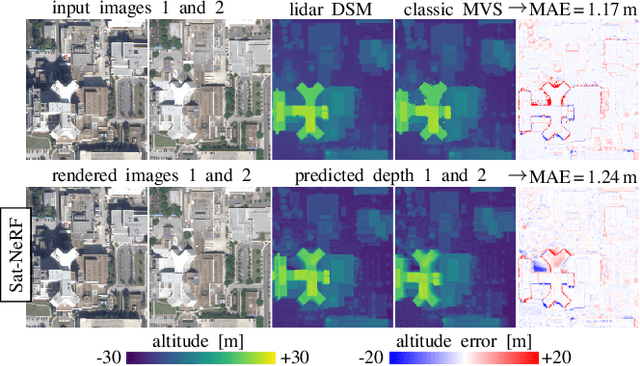



Abstract:We introduce the Satellite Neural Radiance Field (Sat-NeRF), a new end-to-end model for learning multi-view satellite photogrammetry in the wild. Sat-NeRF combines some of the latest trends in neural rendering with native satellite camera models, represented by rational polynomial coefficient (RPC) functions. The proposed method renders new views and infers surface models of similar quality to those obtained with traditional state-of-the-art stereo pipelines. Multi-date images exhibit significant changes in appearance, mainly due to varying shadows and transient objects (cars, vegetation). Robustness to these challenges is achieved by a shadow-aware irradiance model and uncertainty weighting to deal with transient phenomena that cannot be explained by the position of the sun. We evaluate Sat-NeRF using WorldView-3 images from different locations and stress the advantages of applying a bundle adjustment to the satellite camera models prior to training. This boosts the network performance and can optionally be used to extract additional cues for depth supervision.
Automatic Stockpile Volume Monitoring using Multi-view Stereo from SkySat Imagery
Mar 01, 2021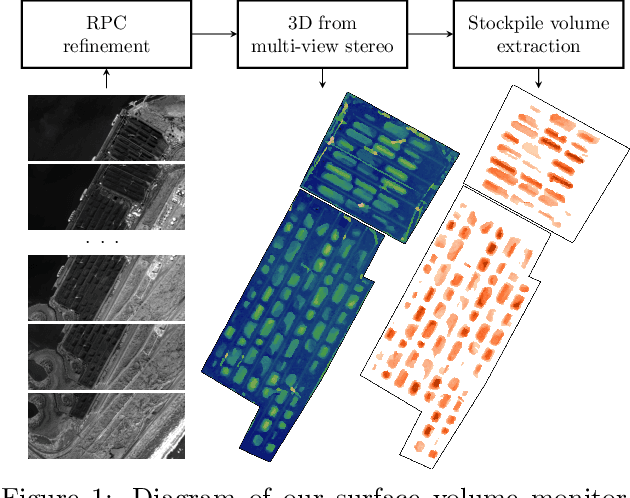

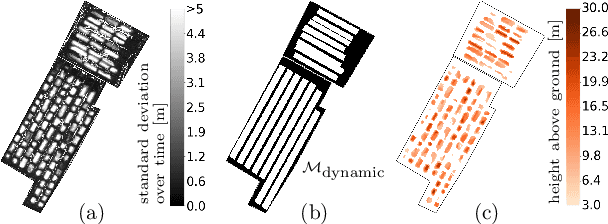

Abstract:This paper proposes a system for automatic surface volume monitoring from time series of SkySat pushframe imagery. A specific challenge of building and comparing large 3D models from SkySat data is to correct inconsistencies between the camera models associated to the multiple views that are necessary to cover the area at a given time, where these camera models are represented as Rational Polynomial Cameras (RPCs). We address the problem by proposing a date-wise RPC refinement, able to handle dynamic areas covered by sets of partially overlapping views. The cameras are refined by means of a rotation that compensates for errors due to inaccurate knowledge of the satellite attitude. The refined RPCs are then used to reconstruct multiple consistent Digital Surface Models (DSMs) from different stereo pairs at each date. RPC refinement strengthens the consistency between the DSMs of each date, which is extremely beneficial to accurately measure volumes in the 3D surface models. The system is tested in a real case scenario, to monitor large coal stockpiles. Our volume estimates are validated with measurements collected on site in the same period of time.
Robust Rational Polynomial Camera Modelling for SAR and Pushbroom Imaging
Feb 26, 2021


Abstract:The Rational Polynomial Camera (RPC) model can be used to describe a variety of image acquisition systems in remote sensing, notably optical and Synthetic Aperture Radar (SAR) sensors. RPC functions relate 3D to 2D coordinates and vice versa, regardless of physical sensor specificities, which has made them an essential tool to harness satellite images in a generic way. This article describes a terrain-independent algorithm to accurately derive a RPC model from a set of 3D-2D point correspondences based on a regularized least squares fit. The performance of the method is assessed by varying the point correspondences and the size of the area that they cover. We test the algorithm on SAR and optical data, to derive RPCs from physical sensor models or from other RPC models after composition with corrective functions.
 Add to Chrome
Add to Chrome Add to Firefox
Add to Firefox Add to Edge
Add to Edge